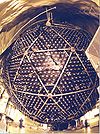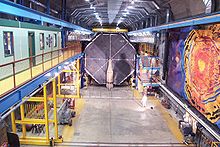- MINOS
-
For other uses, see Minos (disambiguation).
MINOS (or Main Injector Neutrino Oscillation Search) is a particle physics experiment designed to study the phenomena of neutrino oscillations, first discovered by a Super-Kamiokande (Super-K) experiment in 1998. Neutrinos produced by the NuMI ("Neutrinos at Main Injector") beamline at Fermilab near Chicago are observed at two detectors, one very close to where the beam is produced (the near detector), and another much larger detector 735 km away in northern Minnesota (the far detector).
The MINOS experiment started detecting neutrinos from the NuMI beam in February 2005. On 30 March 2006, the MINOS collaboration announced that the analysis of the initial data, collected in 2005, is consistent with neutrino oscillations, with the oscillation parameters which are consistent with Super-K measurements.[1]
Contents
Detectors
There are two detectors in the experiment.
- The near detector is similar to the far detector in design, but smaller in size with a mass of 980 tons (t). It is located at Fermilab, a few hundred meters away from the proton target, and approximately 100 meters underground. The commissioning of the near detector was completed in December 2004, and it is now fully operational.
- The far detector has a mass of 5.4 kt. It is located in the Soudan mine in Northern Minnesota at a depth of 716 meters. The far detector has been fully operational since summer 2003, and has been taking cosmic ray and atmospheric neutrino data since early in its construction.
Both MINOS detectors are steel-scintillator sampling calorimeters made out of alternating planes of magnetized steel and plastic scintillators. The magnetic field causes the path of a muon produced in a muon neutrino interaction to bend, making it possible to distinguish interactions with neutrinos from those with antineutrinos. This feature of the MINOS detectors allows MINOS to search for CPT-violation with atmospheric neutrinos and anti-neutrinos.
Neutrino beam
To produce the NuMI beamline, 120 GeV Main Injector proton pulses hit a water-cooled graphite target. The resulting interactions of protons with the target material produce pions and kaons, which are focused by a system of magnetic horns. The neutrinos from subsequent decays of pions and kaons form the neutrino beam. Most of these are muon neutrinos, with a small electron neutrino contamination. Neutrino interactions in the near detector are used to measure the initial neutrino flux and energy spectrum. Because they are weakly interacting and therefore usually pass through matter, the vast majority of the neutrinos travel through the near detector and the 734 km of rock, then through the far detector and off into space. On the way toward Soudan, about 20% of the muon neutrinos oscillate into other flavors.
Physics goals and results
MINOS measures the difference in neutrino beam composition and energy distribution in the near and far detectors with the aim of producing precision measurements of the neutrino squared mass difference and mixing angle. In addition, MINOS looks for the appearance of electron neutrinos in the far detector, and will either measure or set a limit on the oscillation probability of muon neutrinos into electron neutrinos.
On 29 July 2006, the MINOS collaboration published a paper giving their initial measurements of oscillation parameters as judged from muon neutrino disappearance. These are: Δm2
23 = 2.74+0.44
−0.26 eV2/c4 and sin2(2θ23) > 0.87 (68% confidence limit).[2][3]In 2008 MINOS released a further result using over twice the previous data (3.36×1020 protons-on-target; this includes the first data set). This is the most precise measurement of Δm2. The results are: Δm2
23 = 2.43+0.13
−0.13 eV2/c4 and sin2(2θ23) > 0.90 (90% confidence limit).[4]In 2011, the above results were updated again, using a more than double data sample (exposure of 7.25×1020 protons on target) and improved analysis methodology. The results are: Δm2
23 = 2.32+0.12
−0.08 eV2/c4 and sin2(2θ23) > 0.90 (90% confidence limit).[5]Time of flight of neutrinos
In 2007 MINOS collaboration reported results measuring the flight-time of 3-GeV neutrinos yielding a speed exceeding that of light by 1.8 sigma.[6][7] Those measurements were considered statistically consistent with neutrinos traveling at lightspeed.[8]
References
- ^ "MINOS experiment sheds light on mystery of neutrino disappearance" (Press release). 30 March 2006. http://www.fnal.gov/pub/presspass/press_releases/minos_3-30-06.html. Retrieved 2009-08-03.
- ^ D.G. Michael et al. (2006). "Observation of muon neutrino disappearance with the MINOS detectors in the NuMI neutrino beam". Physical Review Letters 97: 191801. arXiv:hep-ex/0607088. Bibcode 2006PhRvL..97s1801M. doi:10.1103/PhysRevLett.97.191801. PMID 17155614.
- ^ P. Adamson et al. (2008). "Study of muon neutrino disappearance using the Fermilab Main Injector neutrino beam". Physical Review D 77: 072002. arXiv:hep-ex/0711.0769. Bibcode 2008PhRvD..77g2002A. doi:10.1103/PhysRevD.77.072002.
- ^ P. Adamson et al. (2008). "Measurement of neutrino oscillations with the MINOS detectors in the NuMI beam". Physical Review Letters 101: 131802. Bibcode 2008PhRvL.101m1802A. doi:10.1103/PhysRevLett.101.131802. PMID 18851439.
- ^ P. Adamson et al. (2011). "Measurement of the neutrino mass splitting and flavor mixing by MINOS". Physical Review Letters 106: 181801.
- ^ P. Adamson et al. (MINOS), Measurement of neutrino velocity with the MINOS detectors and NuMI neutrino beam, Phys. Rev. D76 (2007) 072005 Arxiv:0706.0437.
- ^ "OPERA experiment reports anomaly in flight time of neutrinos". Fermilab Today. Fermilab. http://www.fnal.gov/pub/today/archive_2011/today11-09-23.html. Retrieved 24 September 2011.
- ^ D. Overbye (22 September 2011). "Tiny neutrinos may have broken cosmic speed limit". New York Times. http://www.nytimes.com/2011/09/23/science/23speed.html. "That group found, although with less precision, that the neutrino speeds were consistent with the speed of light."
Coordinates: 47°49′12″N 92°14′30″W / 47.82°N 92.24167°W
External links
Neutrino detectors, experiments, and facilities Discoveries 
Operating Construction Retired Proposed Cancelled See also Categories:- Accelerator neutrino experiments
Wikimedia Foundation. 2010.

